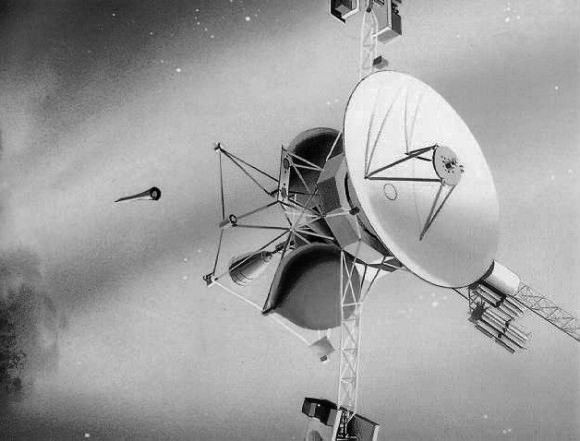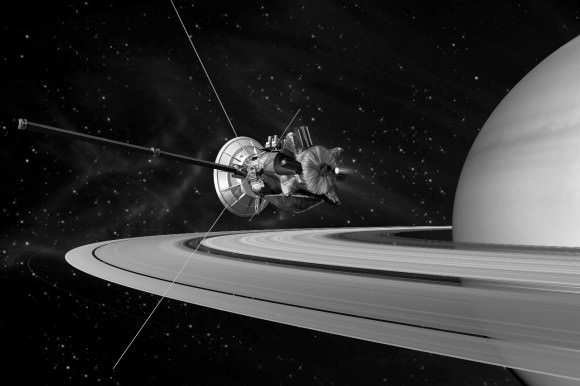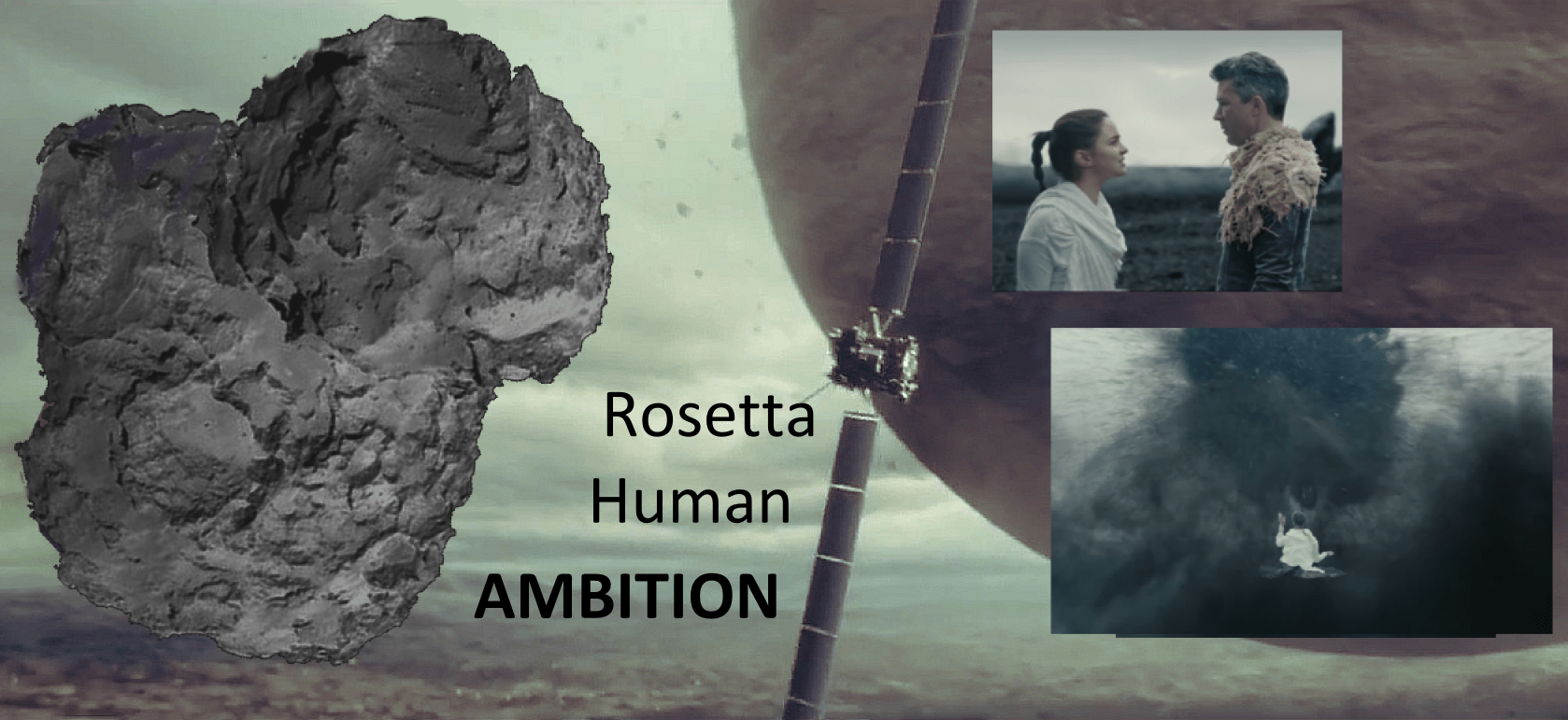NASA has taken on space missions that have taken years to reach their destination; they have more than a dozen ongoing missions throughout the Solar System and have been to comets as well. So why pay any attention to the European Space Agency’s comet mission Rosetta and their new short film, “Ambition”?
‘Ambition’ might accomplish more in 7 minutes than ‘Gravity’ did in 90.
‘Ambition’ is a 7 minute movie created for ESA and Rosetta, shot on location in Iceland, directed by Oscar-winning Tomek Baginski, and stars Aidan Gillen—Littlefinger of ‘Game of Thrones.’ It is an abstraction of the near future where humans have become demigods. An apprentice is working to merge her understanding of existence with her powers to create. And her master steps in to assure she is truly ready to take the next step.
In the reality of today, we struggle to find grounding for the quest and discoveries that make up our lives on a daily basis. Yet, as the Ebola outbreak or the Middle East crisis reminds us, we are far from breaking away. Such events are like the opening scene of ‘Ambition’ when the apprentice’s work explodes in her face.
The ancient Greeks also took great leaps beyond all the surrounding cultures. They imagined themselves as capable of being demigods. Achilles and Heracles were born from their contact with the gods but they remained fallible and mortal.

But consider the abstraction of the Rosetta mission in light of NASA’s ambitions. As an American viewing the European short film, it reminds me that we are not unlike the ancient Greeks. We have seen the heights of our powers and ability to repel and conquer our enemies, and enrich our country. But we stand manifold vulnerable.
In ‘Ambition’ and Rosetta, America can see our European cousins stepping ahead of us. The reality of the Rosetta mission is that a generation ago – 25 years — we had a mission as ambitious called Comet Rendezvous Asteroid Flyby (CRAF). From the minds within NASA and JPL, twin missions were born. They were of the Mariner Mark II spacecraft design for deep space. One was to Saturn and the other – CRAF was to a comet. CRAF was rejected by congress and became an accepted sacrifice by NASA in order to save its twin, the Cassini mission.
The short film ‘Ambition’ and the Rosetta mission is a reminder of what American ambition accomplished in the 60’s – Apollo, and the 70s – the Viking Landers, but then it began to falter in the 80s. The ambition of the Europeans did not lose site of the importance of comets. They are perhaps the ultimate Rosetta stones of our star system. They are unmitigated remnants of what created our planet billions of years ago unlike the asteroids that remained close to the Sun and were altered by its heat and many collisions.

Our cousins picked up a scepter that we dropped and we should take notice that the best that Europe spawned in the last century – the abstract art of Picasso and Stravinsky, rocketry, and jet travel — remains alive today. Europe had the vision to continue a quest to something quite abstract, a comet, while we chose something bigger and more self-evident, Saturn and Titan.
‘Ambition’ shows us the forces at work in and around ESA. They blend the arts with the sciences to bend our minds and force us to imagine what next and why. There have been American epoch films that bend our minds, but yet sometimes it seems we hold back our innate drive to discover and venture out.
NASA recently created a 7 minute film of a harsh reality, the challenge of landing safely on Mars. ESA and Rosetta’s short film reminds us that we are not alone in the quest for knowledge and discovery, both of which set the stage for new growth and invention. America needs to take heed so that we do not wait until we reach the moment when an arrow pierces our heel as with Achilles and we succumb to our challengers.
References:
Rosetta: The Ambition to turn Science Fiction into Science Fact


Thinking different in a bigger way fuels greater risk and sometimes significant gains. Kudos to ESA for “thinking different”. And…rather than seeing this as “us vs them”, let’s think different and start to collaborate as a world society rather than lesser factions. We owe it to ourselves…we owe it to the future of humanity.
Yes. I agree. Unfortunately, CRAF was the first major collaborative effort with ESA and it fell through. The Europeans have grown wary of our lack of fortitude and inconsistency. NASA can bring 3 or 4 times the resources to the table but what use is it if it is does not remain until the end?
Agreed. Various administrations and Congress have used NASA for political purposes. This has drained the passion and vision out of NASA’s once proud history. No shuttle program for the past 3+ years is one example. Where’s the vision of JFK in today’s US leadership (I use the word “leadership” quite begrudgingly)???
Really a great movie! Fingers crossed for Nov, 12th!
I worked on developing the dust sensors for the CRAF mission and was very disappointed when the program was canceled. Then the company I was with started developing laboratory balances for the first generation space station in the early 90s, only the have that project canceled midstream.
NASA swings at the end of a pendulum held by every new administration that comes into office. There is little continuity in space policy from one administration to another, yet we’ve managed to execute some amazing missions – the Mars Rovers and orbiters, Voyager and Pioneer probes, and even with ESA with the hugely successful Cassini mission.
Space is hard, and it is expensive. We must face these facts and realize that we will accomplish more working in collaboration with other space agencies around the world than we will alone. But, we have to have the fortitude to stay the course once we agree to collaborate on a mission.
Ambition is a great film on many levels. It shows what we can accomplish when we are dedicated to task and that our efforts are not in vain and will be appreciated by those who will come after us.
Here, here! Justyn_a_ & rc davison. It is a great film. I agree also that despite all the waste and discontinued projects, there have been incredible successes. Exploration nearly always costs more and takes more time than expected. Fifty percent more of each – well, Ok but two or three times more? Where could we be now if otherwise?
America never lost it’s ambition, as here in the UK, it was buried in the 80’s under a tidal wave of neo con greed (Reganomics and Thatcherism) that relentlessly harried government to cut it’s cloth so that the projects of human endeavour became sidelined unless it could be shown they would make money.
Many politicians don’t understand “adventurous” science and see this kind of stuff as frippery, something to keep the plebs happy. The fact is that all endeavour ultimately pays for itself just maybe not in hard cash.
We’ve certainly had periods, back to what you mention, when our policymakers and legislators were ill-equipped to determine the proper funding and the selection of missions for NASA. The NSF & NASA should have more control of choosing missions and roadmaps but they can’t be left completely to themselves. This has always left Washington with too much authority; oversight – yes, but not the likes of what you describe.
Politicizing good work always kills the ideals that motivates that good work. Politicizing unified effort has divisive results. Kennedy was above the political divisions that could have spoiled what became a truly great, truly national, effort. Later administrations politicized and affected the internal decision-making processes in NASA and funding flow. IMHO, politicians, and particularly those with strong religious persuasions, should keep their g-damned noses out of other people’s good work. Lacking any valid measure of self-respect, they typically fail to recognize the respect deserved in others, except in manipulative ways that eventually benefit their own purposes.
—
[I wish I were a social psychologist. Perhaps I could better explain both why and how many politicians have such an absolutely ruinous effect on national life and well-being.]
Plenum. Thank you for your comments.
You can start with greed and lust for power…it’s a pretty slippery slope from there for any politician. Just ask the many who have betrayed the public trust and were caught.